Willy Martinez's Blog, page 41
May 11, 2023
Salvador Dali as Imagined Through AI
Salvador Dali was born on this day in 1904. Ever since I was a teenager, I have collected his art and art books. In this post, I have asked the #AI machine to imagine his most eye-catching illustration incorporating elements from his paintings and trapping him in a painting he made depicting the horrors of Edgar Allan Poe – another one of my favorite artists from the past.
Which is your favorite, one through six?
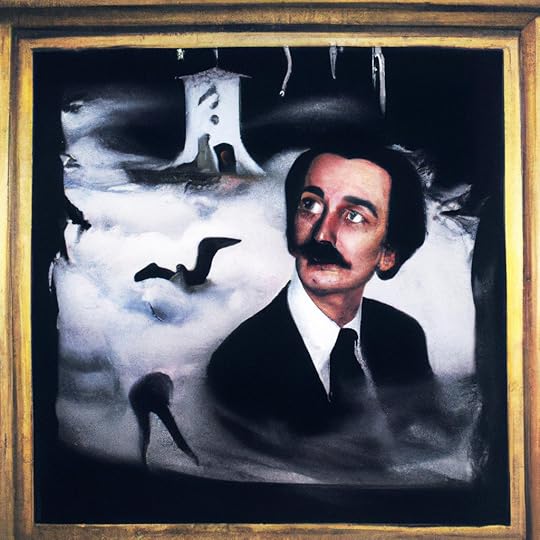
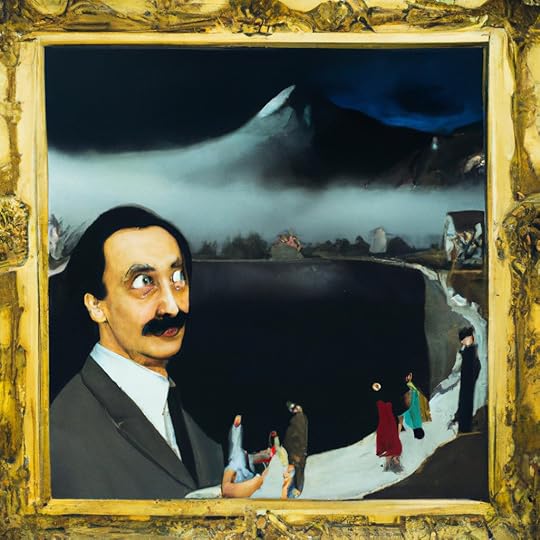
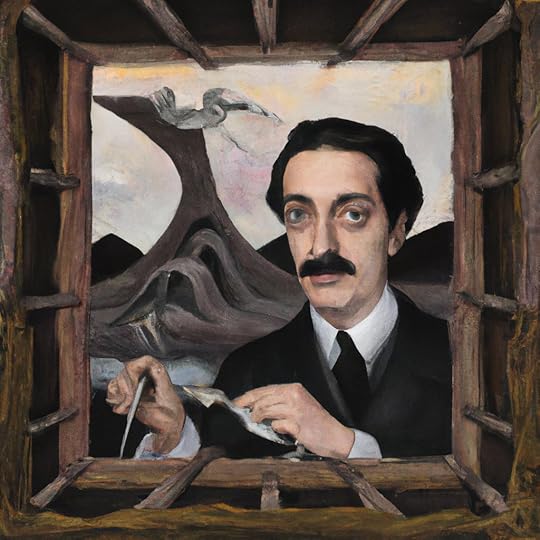
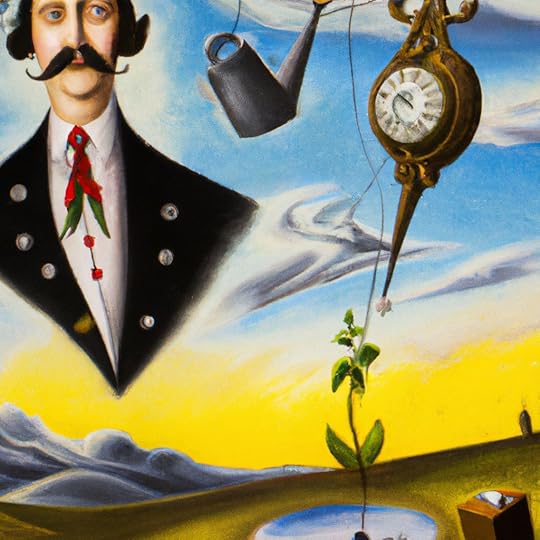

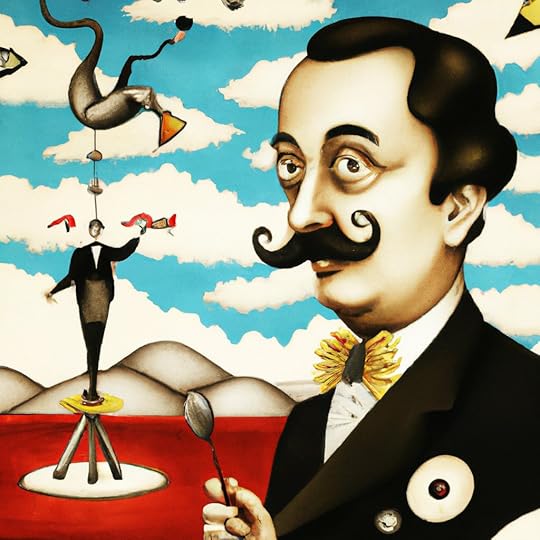
Thank you for visiting with us. For more poetry or Literature related content, visit our blog at The Ritual.
Let’s Read!
We promise not to spam you or share your information with unwanted users. You may unsubscribe at any time.
Processing… Success! You're on the list. Whoops! There was an error and we couldn't process your subscription. Please reload the page and try again.May 4, 2023
Crazy AI Art Inspired by Four Kurt Vonnegut’s Science Fiction Quotes
Kurt Vonnegut is one of the most famous and influential science fiction writers of all time. His unique style and creative use of language have inspired countless readers and writers over the years.
Kurt Vonnegut is one of the most influential writers of the 20th century. His science fiction quotes and books have left a lasting impression on readers around the world.
In recent years, Artificial Intelligence (AI) has been used to generate art that is inspired by Vonnegut’s work. This AI-generated art has had a profound impact on how we think about art, creativity, and storytelling. In this article, we will explore Kurt Vonnegut’s literary impact and the power of AI-generated art. We will look at how AI can be used to create unique works of art that are inspired by his works and how these pieces can help us better understand his writing style.
In honor of Vonnegut’s genius, we decided to make some AI art inspired by his top 4 science fiction quotes.
1. “We are what we pretend to be, so we must be careful about what we pretend to be.”
This quote is a great reminder that our actions and words have an effect on our identity, so we must be careful when deciding who we want to be.
To represent this idea in AI art, we chose to create an image of a robot in the shape of a human. The robot is posed in a way that emphasizes the idea of pretending to be something we are not, as the robot looks like it is trying to imitate the shape of a person.
2. “Maturity is a bitter disappointment for which no remedy exists, unless laughter could be said to remedy anything.”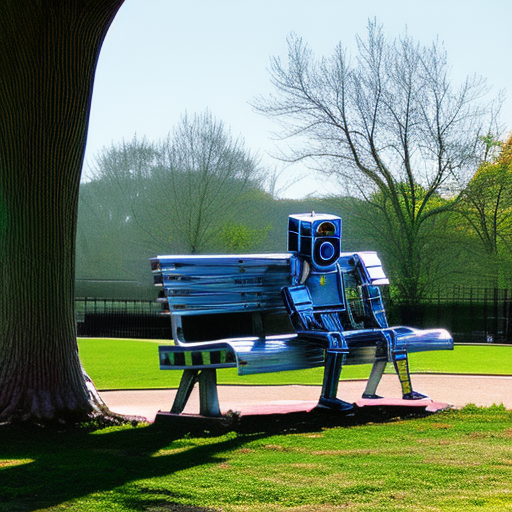
This quote highlights the bitter realities of growing up and the fact that there are no easy solutions to the problems we face as we age.
To represent this quote in AI art, we created a scene of an adult robot sitting on a park bench. The robot appears to be looking off in the distance, perhaps contemplating the hardships of adulthood.
Read also: La Siguanaba is a mysterious figure in Central American folklore that has captured the imagination of many. She is a supernatural woman figure who appears to men in the night, often with a beautiful face and long hair but hides her true form behind it.
Using Generative Adversarial Networks to Create Unique AI ArtGenerative Adversarial Networks (GANs) are a powerful tool for creating AI art. GANs use two neural networks, the Generator, and the Discriminator, to create unique art based on a given set of parameters. The Generator creates new images based on the parameters it is given, while the Discriminator evaluates these images and provides feedback to the Generator so that it can improve its output. By using GANs, artists can create unique pieces of AI art that are unlike anything seen before. This technology has a wide range of applications in fields such as advertising, fashion design, and gaming. GANs also have the potential to revolutionize the way we think about creativity and art in general.
3. “I urge you to please notice when you are happy, and exclaim or murmur or think at some point, ‘If this isn’t nice, I don’t know what is.'”
This quote is a reminder to appreciate the small moments of joy and happiness we experience in our lives.
To represent this quote in AI art, we chose to create a scene of two robots in a garden, looking up at the stars. The robotic figures appear to be in awe of the night sky, a reminder to appreciate the beauty around us.
4. “I want to stand as close to the edge as I can without going over. Out on the edge, you see all kinds of things you can’t see from the center.”
This quote speaks to the importance of taking risks and going outside of our comfort zones in order to discover new opportunities and experiences.
The Future of AI-Generated Art and Its Impact on Pop CultureAI-generated art has the potential to revolutionize the way we consume and create art. With the help of generative models for images, AI can generate realistic and unique pieces of art that have never been seen before. This could have a huge impact on pop culture as it will open up new possibilities for artists to explore and create works that are more complex than ever before.
AI-generated art is also capable of appealing to a wider audience than traditional art forms, making it easier for people to access and appreciate it. By creating artwork that is accessible to all, AI can help bridge the gap between different cultures and bring people closer together through shared experiences.
FacebookTwitterInstagramLinkedInGoodreadsLet’s Read!
We promise not to spam you or share your information with unwanted users. You may unsubscribe at any time.
Processing… Success! You're on the list. Whoops! There was an error and we couldn't process your subscription. Please reload the page and try again.May 2, 2023
Discovering the 3 Most Stunning Libraries in Latin America
Latin-American culture has always had a special affinity towards literature, something that is clearly illustrated in the selection of bookstores we’ve listed below.
Exploring the Beauty and History of Latin American LibrariesLatin American libraries are a hidden gem of beauty and history. From the stunning architecture of the National Library in Mexico City to the rich cultural heritage of the National Library in Bogota, these libraries offer a unique glimpse into the culture and history of Latin America.
These remarkable libraries are not only aesthetically pleasing but also provide an opportunity to explore the rich history and culture of Latin America. From ancient manuscripts to modern literature, each library offers a unique insight into its respective country’s past. Moreover, they also serve as a great source of research and learning opportunities for students and scholars alike.
This article will explore some of the most beautiful and historically significant Latin American libraries, highlighting their importance in preserving Latin American culture and promoting education throughout the region.
The Top 3 Most Beautiful Latin American Libraries1. Anteneo Grand Splendid, Buenos Aires, ArgentinaThis famous bookstore is renowned for its unique location: it is inside a theater, the Grand Splendid, and it fits into its structure to create a unique and beautiful bookshop.
The building was built on the foundations of the National Theater North and was opened in 1919 with the name of Grand Splendid, where great names like Paquita Bernardo, Roberto Firpi, and Carlos Gardel were presented. In fact, Carlos Gardel had a room of his own that still exists inside the building, but there’s not allowed access to the public. The theater installed an antenna on the roof and worked for a few years as Radio Splendid, where Gardel debuted in 1921.
Since 2000, the building has functioned as a bookstore, preserving the architecture of the theater and adapting to its forms. The library offers approximately 120,000 titles and can have 3000 visits per day. To know the Ateneo Grand Splendid is to live a beautiful experience because you will not only be surrounded by great works, but also the space will move you.
One of its most beautiful details is the Dome of Athenaeum, painted by the artist Nazareno Orlandi with technique in oil, where a peaceful scene is represented due to the end of the First World War. This year it was named by the magazine of National Geographic as the most beautiful bookstore in the world.




Read also: The Craziest Things Librarians Have Found in Returned Books!
FacebookTwitterInstagramLinkedInGoodreads2. Coffee shop the Pendulum, Mexico City, MexicoThis bookstore also works as coffee, one of the most beautiful in Mexico City, and is known as Cafebrería el Péndulo, alluding to the sensation of a pendulum that oscillates between coffee and books. The Pendulum is the main place of destination for book lovers who visit the city, it is the perfect place to find great titles and also enjoy a good cup of coffee or tea.
It is located in Polanco and has been among the Top 10 of the most beautiful bookstores in the world. This, in addition, is the place of preference for authors who go on tour to present their books and chat with readers.
The shelves of the books are placed towards the walls and there are small passages that lead to the emptiness of the cafe and to the lower floors that are also full of books. In addition, the decoration based on vines and plants makes the space extremely cozy.
It is a place not to miss, as it not only has an incredible atmosphere but also has precious editions from around the world of literature and art books. You will also find movies and records: it is a place where culture merges.
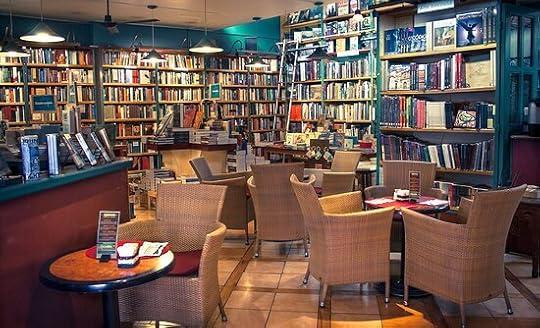



Read also: How to celebrate Library Lovers Month
3. Wilborada 1047, Bogotá, ColombiaThe Wilborada 1047 bookstore is one of the most beautiful spaces you can visit in Bogotá if you love books. Located in a typical house in Bogota and surrounded by the high buildings of the Quinta Camacho neighborhood, this space is a unique place to enjoy a good coffee and a delicious empanada while you are around precious editions of the best authors in the world.
The bookstore’s name is based on Santa Wilborada, the patron of booksellers and books. Some say that the ‘1047’ was because at that time the bookstore opened, others that because that was the time the idea was devised, the hours of attention go from 10:47 to 19:47.
The space of the bookstore accommodates the house that has 4 floors, generating a feeling of rise. Each floor is full of books and chairs to sit in for a while to choose the book you want to take. It also has, on its top floor, a space with poufs where there are graphic novels and illustrated books. The bookstore has a wide variety of literature and a space to show the new voices from the fanzine and more independent publications.
 Visiting a Latin American Library Is an Unforgettable Experience
Visiting a Latin American Library Is an Unforgettable ExperienceVisiting a Latin American library is an experience like no other. You get to explore the vast array of books, manuscripts, and artifacts that are housed in these libraries. Not only do you get to learn about the history and culture of the region, but you also get to enjoy the beauty of its architecture. The feeling of being surrounded by centuries-old books is truly unforgettable. It’s no wonder why so many people choose to visit Latin American libraries when they travel!

Delve into an ancient tale of the Spanish conquest of the Mayan lands in Latin America and discover the truth behind La Siguanaba. Experience a story full of suspense, mystery, and adventure as you uncover the secrets of this mythical being.
La Siguanaba is a mysterious figure in Central American folklore that has captured the imagination of many. She is a supernatural woman figure who appears to men in the night, often with a beautiful face and long hair but hides her true form behind it.
Thank you for visiting with us. For more poetry or Literature related content, visit our blog at The Ritual.
Let’s Read!
We promise not to spam you or share your information with unwanted users. You may unsubscribe at any time.
Processing… Success! You're on the list. Whoops! There was an error and we couldn't process your subscription. Please reload the page and try again.April 27, 2023
A Mayan Love Story: The Legend of Cenote Zaci
The Mayans have a long history of incredible stories and legends, but few are as beloved and iconic as the legend of Cenote Zaci. This is a classic tale of star-crossed lovers and the timeless power of love to overcome any obstacle. Join us for an unforgettable journey back in time to explore this beautiful story and experience its legacy.
A long time ago there were two families that shared the power of the town of Zací: the Cocom and the Cupules. The village healer and sorceress was the head of the Cocom family, a powerful and influential old woman with a granddaughter called Sac Nicté or “white flower.” For his part, the Halach Huinic, belonging to the Cupules, had a son, Prince Hul-kin. Both young people had a friendship that culminated in a passionate love.
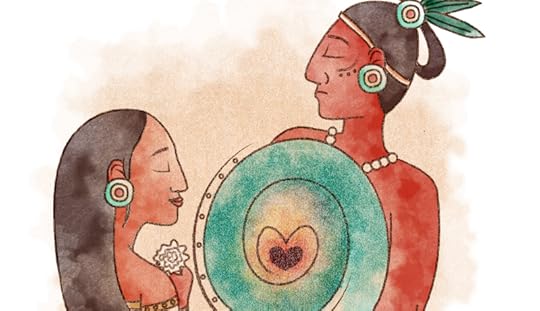 The Mayan Legend of Cenote Zaci
The Mayan Legend of Cenote ZaciUpon learning of this relationship, the chief decided to send the young man to a distant town establishing an alliance so that Hul-kin would marry his princess. Due to the strong love that Sac Nicté felt for the prince, upon learning of his departure, he lost his joy and that sparkle in his eyes. Without more power, she confessed to her grandmother that she was pregnant with Hul-kin.
The sorceress promised the young woman that she would use all her power to bring the prince back. However, when Sac Nicté found out about Hul-kin’s wedding, she decided to tie a stone to her beautiful hair and throw herself into the cenote.
Right at that moment, the prince felt a great pain right in his heart, this took him back to Zací only to find out that his beloved had died. Prisoner of pain, Hul-kin also threw himself into the cenote, letting himself drown to show Sac Nicté the great love he felt for her. The sorceress, seeing this act, said: “I have fulfilled you, Sac Nicté, I have brought you back to your love.”
At the same time, he cast a curse on the cenote, it would take the life of a young man to honor the love of Sac Nicté and Hul-kin.

Thank you for visiting with us. For more poetry or Literature related content, visit our blog at The Ritual.
FacebookTwitterInstagramLinkedInGoodreadsLet’s Read!
We promise not to spam you or share your information with unwanted users. You may unsubscribe at any time.
Processing… Success! You're on the list. Whoops! There was an error and we couldn't process your subscription. Please reload the page and try again.April 26, 2023
3 Utterly Bizarre Reads For Horror Fans
There’s no dearth of genres when it comes to books. Every day, I discover something new, typically a subgenre that, more often than not, pushes the boundaries and presents readers with something new and exciting. The following three utterly bizarre reads fit into the above bracket perfectly.
Before I divulge more about these psychedelic horror stories, I should confess that the last year has been somewhat of a revelation for me. Not only did I grow to love horror books, all thanks to ARCs from BookSirens, but I also discovered the so-called “bizarro” subgenre.
Bizarro is horror to a reasonable extent, but then it’s also outlandish, with hints of pop culture and social commentary thrown in for good measure.
However, from what I’ve read so far, it won’t be everyone’s cup of tea. The extreme episodes interspersed through these stories are pretty wild, to put it mildly. At the…
View original post 502 more words
April 25, 2023
Roses and Alabaster — About

It whispers the ugliest words, echoes of those who hurt the tenderness in us.
Roses and Alabaster — About
Download Free PDFs From Thought Catalog Books — Brianna Wiest, Bianca Sparacino, Parm K.C, And More — Thought Catalog

Thought Catalog Books is the book publishing house that lives inside the Thought Catalog universe. Founded in 2012, we’re one of the most innovative and fastest-growing small businesses in the book publishing world. At Thought Catalog Books, we take great pride in publishing our authors and harnessing deep bonds with them. With this author-first approach…
Download Free PDFs From Thought Catalog Books — Brianna Wiest, Bianca Sparacino, Parm K.C, And More — Thought Catalog
April 19, 2023
The Craft of Writing Characters with Messy Psychology
Written by Suzanne Berne author of the recent novel, The Blue Window, which was published in January 2023 by Marysue Rucci Books, a Scribner imprint. She is the author of four previous novels: The Dogs of Littlefield, The Ghost at the Table, A Perfect Arrangement, and A Crime in the Neighborhood, which won Great Britain’s Orange Prize, now The Women’s Prize.
In the fall of 1973, just as the country finished watching the Watergate hearings, my mother enrolled in classes to become a psychologist. Watergate wasn’t why she decided to go to graduate school—my mother has always been interested in anxiety—but the national atmosphere it created certainly helped. At that time, we were living in Washington, DC, and she couldn’t run to the deli for a jar of pickles without getting caught in conversations about cover-ups and wiretapping, and CIA conspiracies.

As part of her studies, my mother sometimes used my younger sisters and me as practice subjects. She gave us batteries for IQ tests and asked us to interpret inkblots. We answered questions on the Myers Briggs Type Indicator to determine our personality types and whether we were introverts or extroverts. For our participation, we were rewarded with peanut M&Ms and, most meaningfully, her attention, which was hard to come by in a household with three children, three dogs, and my unhappy father, who was even more demanding than the rest of us.
FacebookTwitterInstagramLinkedInGoodreadsThat winter, a slim copy of the second edition of the Diagnostic and Statistical Manual of Mental Disorders (DSM) appeared on my mother’s desk in the little room by the front door she now used as a study. Leafing through it one afternoon, I found a list of ten personality disorders, which were “characterized by deeply ingrained maladaptive patterns of behavior,” and “often recognizable by the time of adolescence.” By then I was thirteen and moody: easily enraged by my sisters, easily mortified at school, tormented by guilt over small offenses and blunders, yet convinced I was destined for greatness (especially when alone in my room). I veered daily between bouts of despair and exultation that would exhaust me now but at the time seemed energizing. I also adored my mother and wanted her to myself. Consulting the DSM, I diagnosed myself with all ten personality disorders the way I once misted myself with her entire collection of perfumes.
“Helltown”- Exploring the Latest Adaptation of Kurt Vonnegut’s Experience With a Serial Killer
Over the next several weeks, I presented my findings to my mother while washing dishes after dinner, one of the few dependable ways to catch her alone. “Possibly you tend to be passive-aggressive,” she might allow, handing me a pot to dry. “We all have dysfunctional tendencies.” I would then offer evidence for why I really was obsessive-compulsive/paranoid/anti-social. If you wanted to edge out your barking, squabbling, brooding competition, the surest way to engage my mother was to be worried about something, especially something complicated. Yet unlike my problems at school or with my sisters, personality disorders failed to capture her attention. The more I insisted on my deeply ingrained maladaptive behaviors, the more blandly my mother reacted. These dishwashing sessions generally ended with a recommendation that I get outside more or invite a friend over, and the dogs, by the way, could use a walk.
It was a deflating response at the time, but I’ve come to believe my mother’s apparent disinterest did signal concern, quite a bit of it. Had she suggested dysfunction by subjecting her children to so much psychological testing? Created it by going to graduate school instead of staying home? (My father’s view.) I’m sure she also wanted to discourage me from embracing any of the conditions I was flirting with. A word is not just a word when it’s a diagnosis.

Thank you for visiting with us. For more poetry or Literature related content, visit our blog at The Ritual.
Whatever the case, confronted with a kitchen sink of disorders claimed by an adolescent reeking of Love’s Baby Soft with a spritz of Styx, my mother was clearly aware that explanations of human behavior are never trustworthy. Especially explanations of one’s own behavior, which are so often shaped as much by convenience, self-importance, and disingenuousness as by an effort to be understood. When it comes to people, my mother must have known, explanations hide as much as they reveal.
Let’s Read!
We promise not to spam you or share your information with unwanted users. You may unsubscribe at any time.
Processing… Success! You're on the list. Whoops! There was an error and we couldn't process your subscription. Please reload the page and try again. TAKE A BREAK FROM THE NEWSWe publish your favorite authors—even the ones you haven’t read yet. Get new fiction, essays, and poetry delivered to your inbox.SUBMIT
My mother went on to become an excellent psychologist, so this recognition ultimately served her well. It’s a recognition that serves novelists well, too. Characters always have problems at the beginning of a story, for example, but rarely do they have a firm understanding of those problems, or themselves, for the simple reason that misconceptions, ambiguities, and, above all, secrets, create drama. “What did the president know, and when did he know it?” Senator Howard Baker’s famous question during the Watergate hearings captured the power of uncertainty. If a character doesn’t know something or is hiding something, readers want that something discovered and explained. We want the facts. We need them in order to feel that the story has been told.
Sea Longing: Poem by Sara Teasdale
If a character doesn’t know something or is hiding something, readers want that something discovered and explained.
But has it? Have the effects of those misunderstandings and ambiguities—those secrets—been resolved? Or have new doubts moved in? Perhaps it’s our current hurricane of misinformation (which makes the lies and dirty tricks of the Watergate scandal look like drizzle), but when it comes to thinking about human behavior these days, I find myself less interested in “the facts” than in how people become so convinced they know them.
While visiting my mother a few months ago, I found my father’s love letters, written to her during their courtship while he was getting divorced from his first wife. He believed he would love my mother forever—something he repeats passionately in those letters—and yet after twenty years of marriage, he divorced her, too. Was it because her attention was even harder to hold once she began seeing patients? Because he resented her success? Because he’d lost his own mother as a child and felt he was losing another? (The view of his third wife, a Jungian analyst.) What did he come to “know,” exactly, that altered how he felt—and when did he know it?
FacebookTwitterInstagramLinkedInGoodreadsAt the time, I was too young to ask my father questions like these, but even if I’d asked him later, I wonder how reliable his answers would have been. It’s hard to get to the truth about yourself, whether you’re a public figure, a teenager, or an elderly man with three failed marriages and many regrets. And if it’s that difficult to comprehend yourself, how on earth can you expect to fathom anyone else? This is not to critique psychotherapy, but rather to say that any analysis of human behavior is bound to leave so much out.
“The personal life of every individual is based on secrecy,” Chekhov writes in “The Lady with the Dog,” adding, “and perhaps it is partly for that reason that civilized man is so nervously anxious that personal privacy be respected.” By secrecy, I think Chekhov is referring not to whatever sins we might be hiding, but to the contradictions and incongruities that can’t be explained about us, that we can’t explain, even to ourselves. A secret inner life is our greatest privilege, but also often our greatest fear. (The current edition of the DSM lists almost three hundred mental disorders and runs over a thousand pages.)
The Supernatural Power of the Sublime in William Wordsworth’s Poetry
Thank you for visiting with us. For more poetry or Literature related content, visit our blog at The Ritual.
Where you can go inside other people’s heads is, of course, the project of the novel, wherein secrets exist to be uncovered. As the critic Janet Malcolm notes in Reading Chekhov, “If privacy is life’s most precious possession, it is fiction’s least considered one,” and goes on to refer, somewhat ruefully, to “the glaring exposure to which the souls of fictional characters are held up.” In other words, characters in a novel transform between the first and the last chapters, sometimes with enormous complexity, but everything there is to be known about them is on the page. If you miss something, you can reread a few chapters to figure out what happened. Characters may behave in puzzling ways, maybe paranoid, anti-social, obsessed with their mothers or their political enemies, or pathological liars who couldn’t accept a fact if you gave it to them in a pickle jar—but eventually you find out why. More or less. As E. M. Forster puts it, “People in a novel can be understood completely, if the novelist wishes.”
And yet, explaining their behavior is not what makes characters relatable.
And yet, explaining their behavior is not what makes characters relatable. In fact, it’s when characters don’t understand themselves very well that readers worry most about them, identify with their difficulties and confusion, and keep reading—which is vital, because characters, unlike people, don’t exist when no one is paying attention to them. What makes the affair between Gurov and Anna in “The Lady with the Dog” so surprising and convincing, for instance, is that they can’t figure out why they have fallen in love with each other, or what to do about it. They truly don’t know their own minds and, as the story suggests by its famously irresolute ending, probably never will. Chekhov, of course, was a master at revealing how emotions we believe should be definite, like love and grief, are full of inconsistencies. He also understood that readers are more deeply intrigued by hesitating characters (see Hamlet) than by decisive ones (see Ivanhoe).
On the other hand, there are those characters who think they understand themselves perfectly and must discover, usually with reluctance, that they don’t—a problem I recently gave to one of my own characters, who is, incidentally, a therapist. In such stories, the reader is usually better informed than the characters, who believe their problems are simply resolvable obstacles and must be forced to see the real trouble they’re in. Frequently this trouble is of their own making, a result of misguided notions and projections. Jane Austen’s Emma thinks she’s shrewd about human nature, yet her assumptions about other people, and her motivations for interfering in their romantic lives, are completely wrong-headed. The reader’s own clear-sightedness becomes part of the drama: we see how Emma is misjudging herself and everyone else, so why can’t she? Anxiously, we hope she wises up before she ruins several futures, including her own. Once again, our engagement with the story is intensified by the character’s lack of self-knowledge, which reminds us, ideally, of our own blind spots. The longer characters can remain somewhat opaque to themselves, or at least have a few questions they keep asking, the more absorbing their predicaments, and the more their worlds feel like ours.
In any case, fictional problems must reach the last page. The story has to end. The reader closes the book, and maybe, that same evening picks up another and gets caught up in a new set of anxieties.
Let’s Read!
We promise not to spam you or share your information with unwanted users. You may unsubscribe at any time.
Processing… Success! You're on the list. Whoops! There was an error and we couldn't process your subscription. Please reload the page and try again.This past summer and fall, I spent hours following the January 6th Select Committee Hearings, which reminded me of watching the Watergate hearings with my parents, fifty years ago, down to the question of what the president knew and when he knew it. My mother’s current view of national politics is that it’s “one big mess,” which was also her opinion during the Watergate era. My mother is now in her late 80s; she still sometimes says she’s bewildered by what happened in her marriage to my father, who is no longer alive. But she doesn’t like dwelling on past unhappiness any more than she likes talking about politics or her health. Anxiety, however, continues to interest her. During a recent phone call, I asked what she was reading. A novel, she told me. “Can’t remember the title,” she said cheerfully, “but the people in it certainly have many problems.”
It’s a strange desire, in this world of trouble, to go seeking other people’s problems, and yet what a relief, for both readers and novelists, to feel that every so often a problem can be completely understood.
About the AuthorSuzanne Berne’s most recent novel, The Blue Window, was published in January 2023 by Marysue Rucci Books, a Scribner imprint. She is the author of four previous novels: The Dogs of Littlefield, The Ghost at the Table, A Perfect Arrangement, and A Crime in the Neighborhood, which won Great Britain’s Orange Prize, now The Women’s Prize. She has taught creative writing at Harvard University, Boston College, and the Ranier Writing Workshop, and lives outside of Boston with her husband.
April 17, 2023
🚨Book Announcement🚨 “La Siguanaba” Available for Pre-Order
Delve into an ancient tale of the Spanish conquest of the Mayan lands in Latin America and discover the truth behind La Siguanaba. Experience a story full of suspense, mystery, and adventure as you uncover the secrets of this mythical being.
Unlock the secrets to this ancient tale and delve into a world full of mystery, suspense, and intrigue. https://mindonfirebooks.com/la-siguanaba/
The short story was already set to pre-order, so it’s going to release on April 24th. Pre-order the eBook today!
The print version will be available as soon as I proof the physical version 
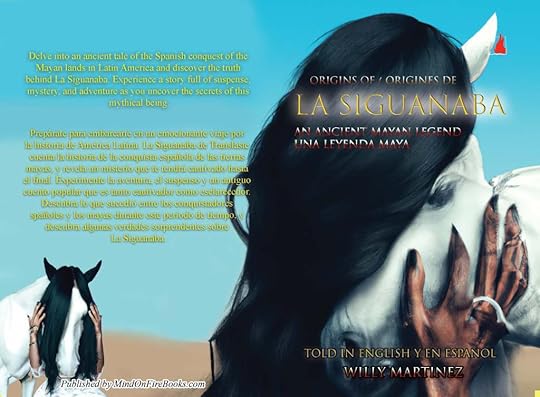
I Told The AI To Imitate My Writing Style And Here Is What Happened
Yes, what the title says is true. And yes, I know, artists don’t dabble with AI. That’s a debate for another blog.
This is a lot more positive than I expected to be honest. It’s actually upbeat – and yeah, it did a great job depicting me. I guess I just figured the story would be more within the Dark Fiction genre since you know, that’s usually the style I write it. But I guess this AI pulled from my bio, my poems, and my science fiction works to punch this one out.
I Told AI to Imitate My Writing Style to Create Flash FictionThe night was cold and still, the snow having fallen quietly a few hours earlier and the air now heavy with its blanket of white. Willy Martinez stood in the middle of the deserted street, the silence that stretched out around him broken only by his own breathing. He looked up at the stars, their distant light twinkling in the sky, and smiled.

Thoughts of his family ran through his mind as he stood in the street, his parents, his brothers, and sisters, their laughter and love still echoing in his memory. He remembered the way his father had taught him to read, the way his mother had sung to him when he was afraid, and the way his siblings had been his constant companions.
He thought of the little house at the end of the street, the one with the broken window, and he smiled sadly. It had been their home, the same one he had grown up in, the same one that had given them shelter and hopes in the bleakest of times.
It had been a long and difficult journey, but he had made it. He had come a long way, and he had achieved more than anyone could have expected. But still, he remembered the past, remembered the good and the bad, and remembered why he had kept going.
And so, with a deep breath, Willy Martinez stepped forward, his feet stirring the snow beneath him, determined to make it to the end of the street. He looked up at the stars, their distant light twinkling in the sky, and smiled. For he was sure of one thing: no matter how difficult the path may have been, he had the courage to keep going.
FacebookTwitterInstagramLinkedInGoodreadsLet’s Read!
We promise not to spam you or share your information with unwanted users. You may unsubscribe at any time.
Processing… Success! You're on the list. Whoops! There was an error and we couldn't process your subscription. Please reload the page and try again.



